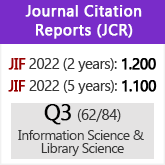Indicators of scientific collaboration between CSIC and Latin America through international databases
DOI:
https://doi.org/10.3989/redc.2008.v31.i1.413Keywords:
bibliometric indicators, scientific collaboration, CSIC, Latin America, Web of ScienceAbstract
This work is based on the analysis of scientific collaboration between the Spanish Research Council (CSIC) and Latin America, in order to study the thematic cooperation and the development of scientific networks. The analysis is significant since CSIC is the Spanish institution with the highest co-authorship with Latin America. Results show that the use of WoS instead of CD ROM increases by 22% the region’s visibility, due to the inclusion of new Chemistry and Materials Science journals. Universities are the main contributors to the relationship between CSIC and Latin America and a strong cooperation in the Physics and Chemistry areas is observed. Activity and impact indicators show that Physics is the strongest point in the CSIC-Latin America collaboration. Network analysis by area shows the institutional connections in each one of them and their different structure. Through citation analysis, a positive relationship between impact and number of participating countries can be detected, revealing the importance of collaboration.
Downloads
References
Arvanitis, R.; Gaillard, J.; Chatelin, Y.; Meyer, J.B.; Schlemmer, B.; Waast, R. (1995). El impacto de los fondos europeos de apoyo a la cooperación científica con países en desarrollo. Interciencia, 20 (2), pp.76-82
Beaver, D. De B.; Rosen, R. (1978). Studies in Scientific Collaboration I. The professional origins of scientific coauthorship. Scientometrics, 1 (1), pp. 65-84
Beaver, D. De B.; Rosen, R. (1979). Studies in Scientific Collaboration II. Scientific co-authorship, research productivity and visibility in the French scientific elite 1799- 1830. Scientometrics, 1 (2), pp. 139-149
Beaver, D. De B.(2001). Reflections on scientific collaboration (and its study): past, present and future. Scientometrics, 52 (3), pp. 365-377.
Bridgstock, M. (1991) The quality of multiple authored papers. An unresolved problem. Scientometrics, 21 (1), pp. 37-48
CINDOC (2000). La actividad científica del CSIC a través del Science Citation Index, Social Sciences Citation Index y Arts & Humanities Citation Index. Estudio bibliométrico del período 1994-1998. Informe. Madrid
CINDOC (2007). La actividad científica del CSIC a través del Web of Science. Estudio bibliométrico del período 2001-2005. Informe. Madrid.
De Filippo, D.; Morillo, F.; Fernández, M.T. (2007). Colaboración científica del CSIC con Latinoamérica. Indicadores para medir las fortalezas de la cooperación. VII Congreso Iberoamericano de Indicadores de Ciencia y Tecnología. San Pablo 25-27 de mayo.
Fernández, M.T.; Agis, A.; Martín, A.; Cabrero, A.; Gómez, I. (1992). Cooperative research projects between the Spanish National Research Council and Latin- American Institutions. Scientometrics, 23 (1), pp. 137-148
Fernández, M.T.; Cabrero, A; Zulueta, M.A.; Gómez, I. (1993). Constructing a Relational Database for Bibliometric Analysis. Research Evaluation, 3 (1), pp. 55-62.
Fernández, M.T.; Sancho, R.; Morillo, F.; De Filippo, D.; Gómez, I. (2005). Indicadores de especialización temática de los países de América Latina y el Caribe. En: ALBORNOZ, M.; RATTO, D. (eds), Indicadores de Ciencia y Tecnología en Iberoamérica. Agenda 2005. RICYT, Buenos Aires, Argentina.
Frame, J.D.; Carpenter, M.P. (1979). International Research Collaboration. Social Studies of Science, 9, pp. 481-497 doi:10.1177/030631277900900405
Glänzel, W. (2001). National characteristics in international scientific co-authorship relations. Scientometrics, 51 (1), pp. 69-115.
Glänzel, W.; De Lange, C. (1997). Modeling and measuring multilateral co-authorship in international scientific collaboration, Part. II A comparative study on the extent and change of international scientific collaboration links. Scientometrics, 40 (3), pp. 605- 626.
Goldfinch S.; Dale, T.; De Roue, K. (2003). Science from the periphery: Collaboration network and «Pheriphery effects» in the citation of New Zeland Crown Research Institutes articles, 1992-2000. Scientometrics, 57 pp. 321-337.
Gómez, I., Fernández, M.T.; Méndez, A. (1995). «Collaboration patterns of Spanish scientific publications in different research areas and disciplines». Proceedings of the Fifth biennial conference of the International Society for scientometrics and informetrics. USA
Gómez, I., Fernández, M.T.; Sebastián, J. (1999). Analysis of the structure of international scientific cooperation network through bibliometric indicators. Scientometrics, 44 (3), pp. 441-447.
Katz, J. S.; Martin, B. (1997). What is research collaboration? Research Policy, 26, pp. 1-18 doi:10.1016/S0048-7333(96)00917-1
Lewison, G. (1991). The advantages of dual nationality. New Scientist, 130. pp. 50-51.
Narin, F.; Stevens, K.; Whitlow, E.S. (1991). Scientific co-operation in Europe and the citation of multinationally authored papers. Scientometrics, 21 (3), pp. 313-323.
Pravdic, N.; Oluic-Vucovic, V. (1991). Distribution of scientific productivity: ambiguities in the assignment of author rank. Scientometrics, 20, pp. 131-144.
Sancho, R.; Morillo, F.; De Filippo, D.; Gómez, I.; Fernández, M.T. (2006). Indicadores de colaboración científica inter-centros en los países de América latina. Interciencia, 31 (4), pp. 328-337.
Van Raan, A.(2006) Performance-related differences of bibliometric statistical properties of researh groups: cumulative advantages and hierarchically layered networks. Journal of the American Society for Information Science and Technology, 57 (14), pp. 1919- 1935. doi:10.1002/asi.20389
Wagner, C. (2005) Six case studies of international collaboration in science. Scientometrics, 62 (1), pp 3-26.
Wagner, C.; Leydesdorff, L. (2005) Network structure, self-organization, and the growth of International collaboration in science. Research Policy, 34, pp. 1608-1618. doi:10.1016/j.respol.2005.08.002
Zitt, M.; Ramanana-Rahary, S.; Basecoulard, E. (2003). Correcting glasses help fair comparisons in international sciences landscape: country indicators as function of ISI databases delineation. Scientometrics, vol 56 (2), pp. 259-282.
Downloads
Published
How to Cite
Issue
Section
License
Copyright (c) 2008 Consejo Superior de Investigaciones Científicas (CSIC)

This work is licensed under a Creative Commons Attribution 4.0 International License.
© CSIC. Manuscripts published in both the printed and online versions of this Journal are the property of Consejo Superior de Investigaciones Científicas, and quoting this source is a requirement for any partial or full reproduction.All contents of this electronic edition, except where otherwise noted, are distributed under a “Creative Commons Attribution 4.0 International” (CC BY 4.0) License. You may read here the basic information and the legal text of the license. The indication of the CC BY 4.0 License must be expressly stated in this way when necessary.
Self-archiving in repositories, personal webpages or similar, of any version other than the published by the Editor, is not allowed.

















